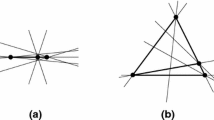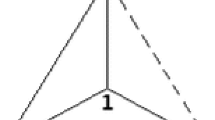Abstract
We construct two combinatorially equivalent line arrangements in the complex projective plane such that the fundamental groups of their complements are not isomorphic. The proof uses a new invariant of the fundamental group of the complement to a line arrangement of a given combinatorial type with respect to isomorphisms inducing the canonical isomorphism of the first homology groups.
Similar content being viewed by others
References
W. Arvola, “The fundamental group of the complement of an arrangement of complex hyperplanes,” Topology, 31:4 (1992), 757–765.
E. Artal Bartolo, J. Carmona Ruber, J. I. Cogolludo Agustín, and M. A. Marco Buzunáriz, “Invariants of combinatorial line arrangements and Rybnikov’s example,” in: Singularity Theory and its Applications, Adv. Studies in Pure Math., vol. 43, Math. Soc. Japan, Tokyo, 2006, 1–34.
T. Kohno, “On the holonomy Lie algebra and the nilpotent completion of the fundamental group of the complement of hypersurfaces,” Nagoya Math. J., 92 (1983), 21–37.
S. MacLane, “Some interpretations of abstract linear dependence in terms of projective geometry,” Amer. J. Math., 58:1 (1936), 236–241.
W. Magnus, A. Karrass, and D. Solitar, Combinatorial Group Theory, Interscience, New York, 1966.
P. Orlik and L. Solomon, “Combinatorics and topology of complements of hyperplanes,” Invent. Math., 56:2 (1980), 167–189.
P. Orlik and H. Terao, Arrangements of Hyperplanes, Springer-Verlag, Berlin, 1992.
G. Rybnikov, On the fundamental group of the complement of a complex hyperplane arrangement, DIMACS Tech. Report 94-13 (1994), 33–50; http://arxiv.org/abs/math/9805056.
D. J. A. Welsh, Matroid Theory, Academic Press, London-New York, 1976.
G. M. Ziegler, “Matroid representations and free arrangements,” Trans. Amer. Math. Soc., 320:2 (1990), 525–541.
Author information
Authors and Affiliations
Corresponding author
Additional information
__________
Translated from Funktsional’ nyi Analiz i Ego Prilozheniya, Vol. 45, No. 2, pp. 71–85, 2011
Original Russian Text Copyright © by G. L. Rybnikov
To the blessed memory of I. M. Gelfand
This work was supported in part by RFBR grant no. 09-01-12185-ofi m, by HSE grant no. 09-09-0010, and by HSE project no. TZ-62.0 “Mathematical investigations in small-dimensional topology, algebraic geometry, and representation theory.”
Rights and permissions
About this article
Cite this article
Rybnikov, G.L. On the fundamental group of the complement of a complex hyperplane arrangement. Funct Anal Its Appl 45, 137–148 (2011). https://doi.org/10.1007/s10688-011-0015-8
Received:
Published:
Issue Date:
DOI: https://doi.org/10.1007/s10688-011-0015-8




